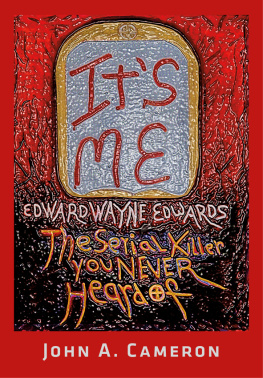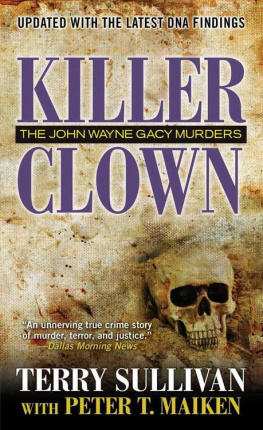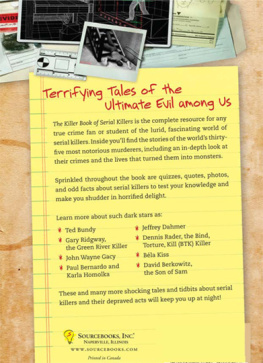In 2010, the accused killer changed his plea and confessed to the brutal slayings of two Wisconsin teens in 1980. He surprised law enforcement by also confessing to the 1977 unsolved murders of two teens on a lovers lane in Ohio. He concluded by providing details of the 1996 execution and beheading of his adopted son, collecting a quarter million in life insurance. Thats it! Thats all I ever killed! he proclaimed.
The story might have ended there, but thats when fate intervened. A text message describing the killers M.O. ended up a thousand miles away in Montana. Retired cold-case Detective John Cameron was intrigued by the way the M.O. matched the unsolved double homicide of two teens on a lovers lane in Great Falls that had taken place over 50 years before, in 1956. He pulled the killers lengthy rap sheet and discovered an arrest and prison time for robbery in Billings, Montana. The date was March 8, 1956.
Convinced this was no coincidence, he spent the next three years following the criminals past, researching records and conducting countless interviews. He exchanged letters and phone calls with the killer and met with his family. The murders were endless. But it was not the total that proved remarkable. It was the names on the list. He did them all.
June, 2009
On March 9, 2009, NBC affiliate WMTV in Madison, Wisconsin, ran a special on a 30-year-old cold case. The brutal murders of Timothy Hack and Kelly Drew had never been solved. No one really expected any results from the airing, but a detective with the Jefferson County Sheriffs Office got a call within a few days from Akron, Ohio. The woman identified herself and then said, I think you need to talk to my father. The detective looked into the tip and his interest skyrocketed when he discovered her fathers name on the list of the 75 suspects that had been interviewed shortly after the murders.
Hack and Drew had been killed in 1980 following a wedding reception near Concord, Wisconsin. Her clothing was found shredded along a road a few days later, but two months passed before their bodies were discovered in a wooded area about eight miles away. Drew had been bound at the ankles and wrists and strangled, a broken hyoid bone in her neck. Hack had a penetrating knife wound to his back.
The tipster had said that her father, Edward Wayne Edwards, had been employed as a handy man by the Concord House, a reception hall, at the time. He aroused suspicion when witnesses saw him with a bloody nose shortly after the murders. He told officials that that incident occurred while deer hunting, but was unavailable for further questioning. He packed up his wife and five children and bolted during the night. As they left town, he pointed to a field and told his children, Theyre going to find a couple of dead kids over there.
Acting on the tip, the detective and a deputy traveled to nearby Louisville, Kentucky, to the address that had been provided by the daughter. An overweight, sickly-looking individual on oxygen answered their knock on the door in a wheel chair. He denied any knowledge of the crime or memory of the incident, but when asked if he had ever been deer hunting, he responded, Oh. That murder.
He eventually submitted to DNA testing and the results came back an exact match. The press excitedly touted, DNA leads to arrest in cold case. In reality, it was the daughters tip and the detectives tenacious follow-up that led to the arrest. DNA only confirmed they had the right suspect.
Due to poor health, Edwards was transferred by air from Louisville to Wisconsin. He pleaded not guilty to the charges and not much happened for almost a year. After 30 years, witnesses were difficult to locate and his court-appointed attorney kept the wolves at bay by petitioning the court for more time to prepare for a possible change of venue to insure an impartial jury.
During that time period the prosecution did discover a few interesting details. Their suspect had once been on the FBIs 10 most wanted list and he had also been looked at as a person of interest in the slayings of two teenagers in Portland, Oregon around Thanksgiving in 1960.
Even more interesting was that the suspect had written and published his autobiography in 1972. The book detailed his life of robberies, escapes, car thefts and other crimes across the country, mostly taking place during the 50s and 60s. The book claimed he was reformed at the age of 35 and was now a successful married family man with 5 children.
With a combined effort of the detective and the Homeland Security Agency, a bulletin was sent to law enforcement in all cities mentioned in the book inquiring if there were any unsolved cases, particularly double murders, which may have occurred during the appropriate time period.
Over a thousand miles away, an officer with the Great Falls Police Department in Montana passed the information on by text message to a retired cold case detective, John Cameron. That started the investigation of Edward Wayne Edwards.
June, 2010
The retired detective was sitting at his desk, day-dreaming as he tossed the orange Nerf ball at the stick-on hoop on the wall. The outer door of his office now announced, Montana Board of Pardons and Parole, but his secretary from his years at the GFPD still sat at a desk in his inner office, running a tight ship, organizing his calendar, and handling calls. Her routine was interrupted when a local detective entered and asked to see Cameron. She recognized him as the new cold case detective in town because her boss had trained and mentored him while still at the department.















